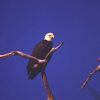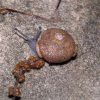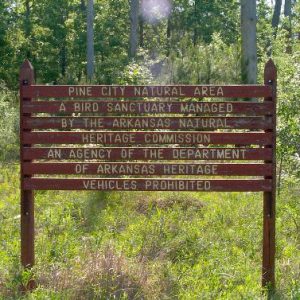calsfoundation@cals.org
Red-cockaded Woodpeckers
aka: Picoides borealis
With the exception of the recently rediscovered ivory-billed woodpecker, red-cockaded woodpeckers (Picoides borealis) are the rarest of Arkansas’s nesting woodpeckers. A century ago, the bird was common in mature, open pine stands. Its natural range included millions of acres of pine habitat throughout the southeast United States. An estimated ninety-nine percent of suitable habitat was lost because of logging, wildfire suppression, conversion to agricultural lands, and urbanization. Best estimates range-wide indicate an original population numbering over four million. By the time the bird was declared endangered, it had declined to an estimated 10,000. The Arkansas population dwindled to under 400 birds.
The red-cockaded woodpecker was designated as endangered on October 13, 1970. It received formal legal protection with the passage of the Endangered Species Act in 1973.
The red-cockaded woodpecker is unique in several ways. It typically lives in a family group that may consist of the breeding male and female, plus offspring from previous years. Each group has only one nest. The offspring help with feeding nestlings and defending the territory. The group maintains an expansive territory that includes a cluster of cavity trees where the birds nest and roost at night.
Red-cockaded woodpeckers are seven to eight inches in length and are clearly distinguished from other woodpeckers by a distinct white cheek patch. The red “cockades” on the male are seen only when the birds are in hand.
Its habitat—termed a “pine grassland”—is characterized by park-like stands of mature pines maintained in an open condition by periodic fire. These fires reduce competition from smaller pines and hardwood trees and foster a diverse undergrowth of native grasses and forbs. Long-term fire suppression resulted in the loss of habitat of many other plant and animal species besides the red-cockaded woodpecker.
The woodpeckers find pines with a heartwood-decaying fungus, primarily Fomes pini. Softened heartwood permits cavity excavation within living pines. Heartwood fungus takes years to develop; an Arkansas study from 1915 showed that the mean age of pines with decaying heartwood in the Ouachita Mountains was 110 years.
The loss of habitat for the red-cockaded woodpecker has had a widespread negative effect on pine ecosystems. For example, at least twenty-seven other vertebrate species use red-cockaded woodpecker cavities. Many plants require sunny, open conditions now rare in pine stands. Most potential habitat today consists of dense stands of second-growth pines and mixed hardwood species. Because of fire suppression, these forests are usually not structurally open. Private timberlands are typically harvested before many trees reach a suitable age for heartwood-softening fungi.
The opportunity for red-cockaded woodpecker recovery is especially good on public lands three decades after passage of the Endangered Species Act. Habitat conservation plans also have been instituted on some industrial forestlands. Artificial cavities and other recently developed management techniques have helped stabilize declining populations and contributed to population growth. Birds have been moved between isolated populations to increase nesting success.
Arkansas’s best opportunity for recovery of the red-cockaded woodpecker involves the USDA Forest Service’s Pine-Bluestem Project on more than 200,000 acres of the Ouachita National Forest in western Arkansas and eastern Oklahoma. While many Arkansas populations have continued to decline, efforts on the Ouachita National Forest have led to a slow recovery. From thirty-two birds in 1990, the population was at least eighty-seven by 2005. This project features red-cockaded woodpecker recovery and includes opportunities for timber harvest, hunting (including focus on Northern Bobwhite population growth), bird-watching, and other recreational activities. It is hoped that, by including many forest uses in the overall plan for recovery, many citizens will have a stake in the ongoing efforts, even if they are not especially interested in these birds.
For additional information:
Conner, Richard N., D. Craig Rudolph, and Jeffrey R. Walters. The Red-cockaded Woodpecker: Surviving in a Fire-maintained Ecosystem. Austin: University of Texas Press, 2001.
Elmore, Jared A., Matthew R. Fullerton, Dillon T. Fogarty, Scott R. Loss. “Do Red-cockaded Woodpecker (Dryobates borealis) Cavity Locations Provide Olfactory Concealment from Predators?” The Wilson Journal of Ornithology 134 (March 2022): 148–154.
Fullerton, Matthew R. “Cavity Tree Selection and Effects of Inter-Annual Weather Variation on Nesting Phenology and Success of Red-Cockaded Woodpeckers in the Ouachita Mountains of Oklahoma and Arkansas.” MS thesis, Oklahoma State University, 2019. Online at https://shareok.org/handle/11244/323392 (accessed June 2, 2021).
Joseph C. Neal
USDA Forest Service
 Birds
Birds Endangered, Threatened, and Rare Species
Endangered, Threatened, and Rare Species Environment
Environment Science and Technology
Science and Technology Tourism
Tourism Pine City Natural Area
Pine City Natural Area  Red-cockaded Woodpecker
Red-cockaded Woodpecker  Red-cockaded Woodpecker
Red-cockaded Woodpecker  Red-cockaded Woodpecker Call
Red-cockaded Woodpecker Call 




Comments
No comments on this entry yet.